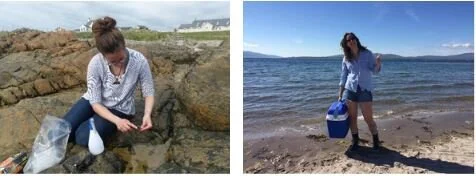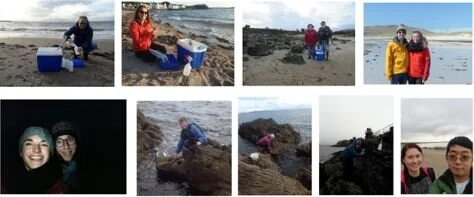Marine Plastics in Scotland – An Interview with Lola Paradinas
BY ALLY HUGHES
Lola Paradinas is a passionate PhD researcher working at the Scottish Association for Marine Science (SAMS), based in Oban on the west coast of Scotland. She grew up on a sailing boat for the first ten years of her life circumnavigating the globe. Being in constant contact with the sea, she learnt to appreciate, respect and protect the marine environment. Snorkelling with her family from a young age led her to develop interests in understanding different marine ecosystems and organism’s interactions. Back in France, Lola undertook a “discovery” internship at Ifremer (French national marine institute) while she was in secondary school. Her curiosity about marine sciences was awoken while she was discovering aquaculture, ecotoxicology and marine ecology. It seemed natural for her to do a BSc in environmental science during which she volunteered to do an internship in marine benthic ecology for several months at one of the marine university laboratories. Her interests for marine ecology and ecotoxicology grew by combining fieldwork and laboratory work. Sure of her path, she pursued a Master’s degree in oceanography and marine environment at UPMC-Sorbonne university (Paris, France) following courses in several marine stations around France, which deliver strong knowledge about marine sciences. After studying the ecology of deep-water corals, she focussed on microplastics studies, which are plastic debris smaller than 5 millimetres. Microplastic pollution is something she took to heart, understanding how big of a threat it can be for marine environments. It is a worldwide pollution where plastic debris is found from the deepest trench to the highest mountain. Plastic pollution occurs everywhere. Lola worked first on microplastics in anemones and jellyfishes at GMIT-Galway in Ireland; prior to studying the occurrence and dynamic of microplastics along the Scottish coastline during her PhD.
What is the focus of your PhD research? Why was this project of particular interest for you?
My PhD project involves the study of the occurrence and dynamics of microplastic particles in coastal water, sand and wild mussels at six sites along the North and West coasts of Scotland. The influence of seasons and sites’ locations on microplastic variations are being investigated. Another part of my PhD is to focus on the tides' influence on microplastic abundances on a beach to better understand the dynamics of small plastic particles on sandy shores. Understanding the dynamics of microplastics along the coast is the next step in finding solutions and target areas where this pollution is predominant, and involves scientists, policy makers and industry.
What does a typical day of fieldwork look like for you?
A typical day of fieldwork starts way before the real sampling day. I have to contact our volunteers and send them sampling kits ahead of D-day. Then I have to make sure of the logistics for visiting the sampling site (isle of Tiree), check the weather and the tides times. Finally, when we can go into the field, we collect water, sediment and mussels, making sure there is no contamination in any of your samples and store everything safely for the trip back to the laboratory. Then back at SAMS, we are unpacking, storing everything in the fridge or freezer and cleaning all the materials to leave things ready for the next sampling campaign. Lastly, I check before, during and after the sampling if everything went smoothly for the volunteers. Without them it would be very difficult to carry on with the project.
Lola conducting fieldwork on the isle of Tiree and along the Oban coast.
Who are your volunteers?
Citizen scientists were recruited through professional contacts via emails, combined with the NERC funded Capturing our Coast citizen science project. The team of citizen scientists are postgraduate students at UHI partner institutes, Natural History Trust volunteers, and those who had been directly involved in the CoCoast programme (10 participants in total).
Photos of volunteers working on Lola’s project
It is very exciting because even if you are well-prepared, there is always something unexpected happening which is why I love fieldwork. It is always an adventure by itself. Sometimes I had to collect water or sediment at night, or under the snow in the middle of winter and the sediment was frozen, other times it was in the middle of summer and the sun was shining. No two days of fieldwork are the same!
What is one thing about the marine plastic pollution that you wish everyone knew?
The 5R rule is a simple process to work on to help you ditch plastic from your daily life: “Reduce, Refuse, Reuse, Recycle, and Remove”. Applying this rule as much as you can by starting with small steps. If thousands of people are doing it, it can definitely make a change.
What, in your opinion, is the most important approach to dealing with marine plastic pollution?
We need our government and policy makers to take action against plastic pollution. We need industries to change their way of producing and find sustainable alternatives to plastic and we need everyone to change their habits and be a bit more responsible in their actions.
Everyone can do something at his or her own scale. It is not only a matter for scientists, governments and companies. Everyone should be aware of this pollution and try to make small moves and change their way of living by starting to ditch single use plastics and be respectful to the environment. The key is to diversify the use of materials in your life for clothes, objects and so on to not put pressure on only one resource but spread it to many other materials.




